Summary
2018 Grid of the Future, Reston, VA
- 2018-1-Impact of GIC on Noise Performance of Large Power Transformers
- 2018-2-Comparison of Measured and Simulated Geomagnetically Induced Currents in TVA Using Different Conductivity Structures and Network Parameters
- 2018-3-GIC Magnetic and Thermal Assessment of TVA’s Fleet of 500kV Transformers
- 2018-4-The Case for Stronger Grid Interconnections in Canada
- 2018-5-Developing a Distribution Grid Model Data Management Architecture
- 2018-6-Modeling Distribution Feeder with Distributed Generation (DG) in ASPEN
- 2018-7-Addressing New Challenges in Distribution Planning
- 2018-8-Weather-Normalized Demand Analytics
- 2018-9-Cable Train In-Situ Manufacturing Trackside Underground Cable HVDC Transmission Systems
- 2018-10-Insulator Contamination Assessment and Mitigation for AC and DC Overhead Lines
- 2018-11-An Analysis on the Economic Impacts of Dynamic Line Ratings on a Congested Transmission Line in Southwest Power Pool
- 2018-12-Simulating the Economic Impact of a Dynamic Line Rating Project in a Regional Transmission Operator (RTO) Environment
- 2018-13-Improve Protection Communications Network Reliability Through Software-Defined Process Bus
- 2018-14-Continuous Automated Analysis of Protection Scheme Communications Leads to Improved Reliability and Performance
- 2018-15-Process Bus Busbar Protection A Stepping Stone Towards Digital Substation
- 2018-16-Automated Fault Location Analysis Analytics Update
- 2018-17-Maximizing the Impact of an Energy Storage Project
- 2018-18-Calculating the Capacity Value and Resource Adequacy of Energy Storage on High Solar Grids
- 2018-19-Driving the Performance of Modern Electric Grid Using Battery Energy Storage Systems AEP Transmission Experience
- 2018-20-Techno-Economic Review of Battery Energy Storage Systems
- 2018-21-The Resiliency Continuum
- 2018-22-Achieving SAIFI Improvement Objectives by Increasing Medium-Voltage Looped-Feeder Segmentation
- 2018-23-Improving Reliability and Safety of Electric Power Delivery Using DFA Technology
- 2018-24-Smart Cities and the Ideas that Light Them
- 2018-25-Automated Enhancement of Transmission Planning Bus-Branch Model with EMS Node-Breaker Substation Models
- 2018-26-Transmission Line Capacity Forecasting System
- 2018-27-Design and Implementation of an Extensible Platform for Large Scale, Programmatic Transmission Outage Planning Analysis
- 2018-28-Turnkey Solutions for Grid Modernization
- 2018-29-Leveraging Private LTE Networks in the Electric Utility
- 2018-30-Active Management of Communication Resources in a Modern Power System Environment
- 2018-31-Use of Cellular Communication to Remotely Deploy Distribution Automation Functionality
- 2018-32-Validating a Google TensorFlow Image Classifier
- 2018-33-Machine Learning Techniques in Support of Better Asset Life Estimation – Let the Data Surprise You
- 2018-34-Latent Variable Survival Models for Network Transformer Prognostics
- 2018-35-Analytics in Practice Someone Has to Know What is Going On
- 2018-36-A Faster FEM Based Approach for Obtaining Steady State Transformer Winding Currents under GIC
- 2018-37-The Definition of Reliability in Light of New Developments in Various Devices and Services Offering Customers and System Operators New Levels of Flexibility Summary of Technical Brochure 715
- 2018-38-Analysis of Pricing Trends and Grid Parity of Photovoltaic Systems
- 2018-39-Parameterization of Aggregated Distributed Energy Resources (DER_A) Model for Transmission Planning Studies
- 2018-40-Visualizing the Grid of the Future
- 2018-41-Study Results of the Impact of a Modular SSSC to Transmission Line Protection Schemes
- 2018-42-Impact of Renewable Energy Sources on Power Quality of Grid
- 2018-43-Reliability Impact of Distributed Energy Resources on Bulk Electric System
- 2018-44-Optimal Allocation of Small Low-voltage Controllable Capacitors
- 2018-45-Adaptive Wide-Area Damping Control Using Transfer Function Model Derived from Ring-down Measurements
- 2018-46-IDtools An Automated Tool for Modal Identification from Time-domain Simulation Results for Establishing System Operating Limits
- 2018-47-Using Computational Fluid Dynamics to Assess Dynamic Line Ratings in Southern Idaho
- 2018-48-Power Flow Control Solutions for the Bonneville Power Administration Transmission System
- 2018-49-Wideband Voltage Sensors for the Modern Substation
- 2018-50-AEPs Experience in Improving Overall Efficiency of Power Transmission Station Projects Using Integrated Design and Construction (IDC) Process and Prefabricated Construction
- 2018-51-Design Principles for AC Station Service Connections in EHV Substations
- 2018-52-AEP Station Bus and Conductor Ampacity Calculation Methodologies
- 2018-53-Field Demonstration of Smart Inverter Autonomous Voltage Support Using Combined Volt-Watt and Volt-VAR Curves
- 2018-54-Field Demonstration of Distributed Energy Resource Management System (DERMS) with ADMS
- 2018-55-Generalized Approach for Volt-VAr-Control through Integration of DERs with Traditional Methods
- 2018-56-Coordinated Industry Development of DERMS Control Functions
- 2018-57-Gas Insulated Substations (GIS) for Enhanced Resiliency
- 2018-58-Practical Guidance for the Renewal of Gas Insulated Substations
- 2018-59-Challenges of Grounding When Upgrading Substations and Security Fences
- 2018-60-Structural Design of Substation Steel Structures Seismic Load Considerations
- 2018-61-A Comparative Study of the Reliability of Reverse Power and Directional Overcurrent Elements for Distribution Level Fault Identification
- 2018-62-Intelligent Circuit Sensor Enabled Fault Detection, Isolation and Restoration for Transmission Lines with T-connection Taps
- 2018-63-Adaptive Protection System with On-line Protection Security Assessment in Distribution Systems with High Penetration of DERs
- 2018-64-Assessment of Protection Functionality and Performance with Respect to Declining System Fault Levels and Inertia due to a Significant Increase of Inverter Based Generation on National Grid’s Transmission System in the United Kingdom
- 2018-65-Value of the Distributed Energy Resources to Distribution Grid
- 2018-66-Lessons Learned from Performing an Integration Capacity Analysis (ICA)
- 2018-67-A Direct Calculation of Locational Marginal Value of Distributed Energy Resources
- 2018-68-Impact of Grid Reconfiguration in Distribution Market Clearing and Settlement
- 2018-69-Data Governance Driven Visualizations with PI Data Historian in Dominion Energy
- 2018-70-A Universal Sensor Analytics and Artificial Intelligence Platform for the Grid
- 2018-71-Residential Customer Clustering at Dominion Energy Towards Big Data Analytics
- 2018-72-Analytics at Warp Speed From Prototypes to Production
- 2018-73-The Transformer-less Unified Power Flow Controller (TUPFC) for Power Flow Control at Normally-Open Primary-Ties
- 2018-74-Spinning Reserve Based Topology Control in Holonic Distribution Grids
- 2018-75-Blackstart Studies for Future Scenarios
- 2018-76-Envisioning the Possibilities in an Interconnected Future
- 2018-77-Installation and Commissioning of Mitsubishi Electric’s MMC STATCOM (SVC DiamondTM) at Dominion Energy’s Colington Substation
- 2018-78-Voltage Security Analysis of VSC-HVDC Transmission Lines
- 2018-79-Modelling and Control of Static Synchronous Compensators (STATCOMs)
- 2018-80-HVDC Planning Considerations for Offshore Wind Integration
- 2018-81-Microgrid Systems Design, Control Functions, Modeling and Field Experience
- 2018-82-Dynamic Solar Hosting Capacity Calculations in Microgrids
- 2018-83-Microgrid Nanogrid Project Proposals Using HOMER Energy for Economic, Performance, and Environmental Optimization and Estimates
- 2018-84-Design and Synchronization of the Dominion Energy Microgrid
- 2018-85-Hosting Capacity When Considering Controlled Aggregate DER
- 2018-86-A Fast Hosting Capacity Calculation Method for Large Distribution Grids
- 2018-87-Accuracy of Translating Generic DER ‘Agnostic’ Hosting Capacity to Specific DER Types
- 2018-88-Lessons Learned in PMU (SynchroPhasor) at AEP
- 2018-89-Simulation of 2017 Wind Farms into Series Capacitor Sub-Synchronous Oscillation Events
- 2018-90-Artificial Intelligence Assisted Power Grid Hardening in Response to Extreme Weather Events
- 2018-91-Analysis and Impact of Autonomous Fast Frequency Response Relative to Synchronous Machine Sources on Oahu
- 2018-92-Moving Beyond Reliability Based KPIs
- 2018-93-Solar Shading vs. Fault Conditions From a Utility View
- 2018-94-IED System Management Solution A Universal Approach for all your Grid IoT Integration
- 2018-95-Its Time to Embrace Artificial Intelligence for the Utility Industry
- 2018-96-A Take on Augmented and Virtual Reality Applications in the Utility Industry
- 2018-97-A Survey of Cybersecurity Frameworks
- 2018-98-Substation Cybersecurity; an Asset Management Viewpoint
- 2018-99-Boundary Protection for Transmission Facilities
Additional informations
| Publication type | Colloquia |
|---|---|
| Reference | COLL_RES_2018 |
| Publication year | |
| Publisher | CIGRE National Committee |
| Price for non member | Free |
| Price for member | Free |



